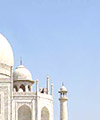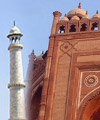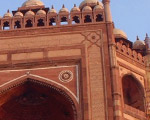|
Kushinagar
Kushinagar, one of the principal centers of Buddhist pilgrimage
is the place of Mahaparinrvana. The monument of Kushinagar are situated
in three distinct comprising in the main site of the Nirvana Temple
houses over 6meter long statue of the reclining Buddha The image
was unearthed during the excavations in 1876. An inscription below
dates the statue to the 5th century BC Mathakaur shrine is black
stone image of Lord Buddha in the Bhumi Sparsha Mudra (a posture
showing him touching the earth ) was recovered here.
The credit for bringing this ancient site to light goes to General
A. Cunningham and A.C.I. Carlyl, who, after excavating the site
in 1861, established its antiquity for the first time. Later, between
1904 and 1912, several excavations conducted by the Archaeological
Survey of India at Kushinagar confirmed its identity.
Kushinagar is situated in the north Indian state of Uttar Pradesh,
51 km off Gorakhpur. The place, which is famous for the Mahaparinirvana
(death) of Lord Buddha, has been included in the famous Buddhist
trail encompassing Bihar, Uttar Pradesh, and Nepal.
Excursion
Nirvana
Stupa
This huge brickwork stupa, exposed by Carlleyl in 1867, stands at
a height of 2.74 meter. A copper vessel was unearthed at this site.
It bore an inscription in ancient Brahmi, which stated that Lord
Buddha's remains had been deposited here. The Stupa is located in
the east of the main Nirvana Temple.
Nirvana Temple
This houses the over 6 meters long statue of reclining Buddha. The
image was unearthed during the excavations of 1876. Carved from
Chunar sandstone, the statue represents the dying Buddha reclining
on his right side. An inscription below dates the statue to the
fifth century AD.
The temple stands on the same plinth as the Stupa behind it. As
mentioned above the ruins of this temple and the reclining Nirvana
statue inside were discovered by Carlleyl in 1876. By sinking a
vertical trench at the centre of its mound he first discovered the
great statue in a much-shattered condition lying on a broken pedestal.
Mathakuar Shrine
This Shrine lies about 400 yards form the Parinirvana stupa. A black
stone image of the Buddha in the bhumi sparsha mudra was recovered
here. The last sermon by Lord Buddha was given here.
More than a furlong south-west of the Main Site, by the side of
the road, is the Matha-kuar shrine, wherein is installed a colossal
statue of Buddha, locally called Matha-kuar. The possible significance
of its name has already been referred to. The statue measures 3.05
m in height and is carved out of one block of the blue stone of
the Gaya region to represent Buddha seated under the Bodhi tree
in a pose known as the bhumisparsa-mudra ('earth-touching attitude'),
which symbolically expresses the supreme moment in Buddha's life
just before his Enlightenment, when he called upon the Earth to
bear witness to the pieties performed by him in his previous births.
Ramabhar Stupa
About 1 km away, this large stupa rises to a height of 49 ft. It
marks the site where the Lord Buddha was cremated. In ancient Buddhist
texts this stupa has been referred to as Mukut-Bandhan Vihar. Alias
THE CREMATION STUPA Less than 1.61 km to the east of the Matha-kuar
shrine stands a mound facing the road from Kasia to Deoria. There
is a sheet of water, called Ramabhar Jhil or pond, close to it,
which dries up in summer. Whether the name Ramabhar originally belonged
to the pond or to the mound it is difficult to say; nor can it be
satisfactorily derived or its relation to the events of Buddha's
death easily explained.
Japanese
Temple
A beautiful Ashta Dhatu (eight metlas) statue of Lord Buddha, which
came from Japan, can be seen here. Built by the Atago Isshin World
Buddhist Cultural Association, it consists of a single circular
chamber, housing a golden image of Buddha, softly lit through small,
stained-glass window.
Kushinagar Museum
The Buddha Museum contains finds from excavations at the site. The
museum has 248 precious antiques related to coins, statues and sculptures,
architectural remains & bronze statues.
The proposal was mooted to found a museum for preserving the archaeological
wealth from the region and the present building came into existence
in 1992-93. it is located at about 1 km. Sough-East from the Kushinagar
bus stop, ½ km. From the Mahaparinirvana temple and about
3 Km. From the Kasia bus stand. The nucleolus of the collection
represents sculptures, terracottas particularly the Buddhist icons,
architectural remains, bronzes, clay seals, banner paintings (Thankas)
and a few coins. Besides , some Hindu and Jaina antiquities are
also on view. The Stucco statue of Lord Buddha in the meditation
posture is a superb specimen. It represents zenith of the Gandhara
School of Art.
Japanese Garden
The Children park in the front of Buddha Museum is under construction.
The park is initially under Japanese eye of construction and will
be handed over to the UP Government on completion. The park can
be partially viewed as a rock garden.
Buddha
Vihar
The Myanmar Buddha Vihar, first Monastry in Kushinagar, attracts
the tourist with many of its Buddhist temples inside their monastery.
The temples are equipped with beautiful metal statues of Lord Buddha
and a rare collection of Excavated Bone & Metals (Asthidhatu)
of Lords and followers. The Burmese Buddha Vihar also holds the
main charge for conducting Prayers in Mahaparinirvana Temple.
A huge "Samridhi Chaitya" Stupa which will contain 5000
brass statues of Lord Buddha from all over the World is under construction
and is likely to be inaugurated by 1st week of February 2001.
Wat Thai Temple
The one of its kind, this Buddhist temple can be seen with wide
open eyes in Kushinagar. The temple flourishes on its greenery well
spread and pleasant atmosphere. The beautiful Temple was designed
to be the forest- monastery gathering innumerable kinds of trees
as to commemorate the Golden Jubilee Celebrations of His Majesty
King Bhumibol the Great's Accession to the Throne. The construction
of the temple is compleated but the doors of the temple are likely
to be opened by 2001 for general public.
Chinese Temple
The Lin Sun Chinese Temple is the another attraction of Kushinagar,
The temple attracts the beautiful Chinese image of Lord Buddha.
The exterior looks of the temple gives a mix view of Chinese and
Vietnamese architecture. The temple also provides free stay facility
to the Buddhist tourists.
Top
Getting There
By Air
The nearest airport is Gorakhpur (44km).
By Rail
The nearest rail head or station is Gorakhpur : 51 km, which is
the headquarters of North Eastern Railways and linked to important
destinations. Gorakhpur is connected directly with Mumbai, Delhi,
Cochin and Barauni.
By Road
Situated on National Highway No. 28, Kushinagar is well connected
with other parts of the state. Some major road distances are : Gorakhpur-51
km, Lumbini-173 km, Kapilastu-148 km, Sravasti-254 km, Sarnath 266
km. Lalitpur 33 km from Deogarh.
Top
General Information & Accomdation info on Kushinagar city of
Uttar Pradesh - India
|






